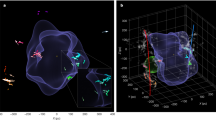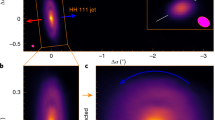Abstract
CONTINUING observations of the nebula around SN1987A, which is about 3 arcseconds across, show it to be surprisingly regular. The brightest part of it is a highly axisymmetric structure, perhaps a simple ring1–4. This structure, which may be related to similar structures in planetary nebulae and around Wolf–Rayet stars, poses a challenge for current nebular formation theories. Here we discuss the formation of an axisymmetric nebula in terms of the interaction between the slow wind ejected by the progenitor of SN1987A while it was a red supergiant (RSG) and the subsequent fast wind produced by the same star after it had evolved into a blue supergiant (BSG). In our model, an initial small asymmetry in the RSG wind, due to rotation of the red giant, is amplified by the action of the fast BSG wind. Structures that are significantly axisymmetric, and perhaps even ring-like, can be produced. We suggest that such phenomena should be common in the formation of nebulae, as evidenced by the fact that only a small fraction of the observed circumstellar nebulae appear to be spherically symmetric.
This is a preview of subscription content, access via your institution
Access options
Subscribe to this journal
Receive 51 print issues and online access
$199.00 per year
only $3.90 per issue
Buy this article
- Purchase on Springer Link
- Instant access to full article PDF
Prices may be subject to local taxes which are calculated during checkout
Similar content being viewed by others
References
Crotts, A. P. S., Kunkel, W. E. & McCarthy, P. J. Astrophys. J. 347, L61–64 (1989).
Wampler, E. J. et al. Astrophys. J. 362, L13–16 (1990).
Jakobson, P. et al. Astrophys. J. 369, L83–66 (1991).
Crotts, A. P. S. & Heathcote, S. R. Nature 350, 683–685 (1991).
Fransson, C. et al. Astrophys. J. 336, 429–441 (1989).
Wampler, E. J. & Richichi, A. Astr. Astrophys 217, L21–24 (1989).
Maeder, A. in Proc. ESO Workshop on SN1987A (ed. Danziger, I. J.) 251–270 (Reidel, Dordrecht, 1987).
Castor, J., McCray, R. & Weaver, R. Astrophys. J. 200, L107–110 (1975).
Chevalier, R. A. Nature 332, 514–516 (1988).
Kahn, F. D. & West, K. A. Mon. Not R astr. Soc. 212, 837–850 (1985).
Wang, L. Astr. Astrophys. 246, L69–72 (1991).
Luo, D. & McCray, R. Astrophys. J. (in the press).
Chevalier, R. A. & Soker, N. Astrophys. J. 341, 867–882 (1989).
Podsiadlowski, P. Nature 350, 654 (1991).
Fransson, C. & Chevalier, R. A. Nature 328, 44–45 (1988).
Author information
Authors and Affiliations
Rights and permissions
About this article
Cite this article
Wang, L., Mazzali, P. Dynamical development of a ring-like structure in the supernova 1987A nebula. Nature 355, 58–61 (1992). https://doi.org/10.1038/355058a0
Received:
Accepted:
Issue Date:
DOI: https://doi.org/10.1038/355058a0
This article is cited by
-
The shaping of planetary nebulae and the SN 1987A nebula
Astrophysics and Space Science (1996)
-
Is the ring around SN1987A a protostellar disk?
Nature (1994)
-
Supernova 1987A at five years of age
Nature (1992)
-
Napoleon's hat
Nature (1992)
Comments
By submitting a comment you agree to abide by our Terms and Community Guidelines. If you find something abusive or that does not comply with our terms or guidelines please flag it as inappropriate.



